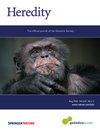Revealing stable SNPs and genomic prediction insights across environments enhance breeding strategies of productivity, defense, and climate-adaptability traits in white spruce
IF 3.9
2区 生物学
Q2 ECOLOGY
引用次数: 0
Abstract
Exploring the relationship between phenotype, genotype, and environment is essential in quantitative genetics. Considering the complex genetic architecture of economically important traits, integrating genotype-by-environment interactions in a genome-wide association (GWAS) and genomic prediction (GP) framework is imperative. This integration is crucial for identifying robust markers with stability across diverse environments and improving the predictive accuracy of individuals’ performance within specific target environments. We conducted a multi-environment GWAS and GP analysis for 30 productivity, defense, and climate-adaptability traits on 1540 white spruce trees from Alberta, Canada, genotyped for 467,224 SNPs and growing across three environments. We identified 563 significant associations (p-value < 1.07 ×10−05) across the studied traits and environments, with 105 SNPs showing overlapping associations in two or three environments. Wood density, myrcene, total monoterpenes, α-pinene, and catechin exhibited the highest overlap (>50%) across environments. Gas exchange traits, including intercellular CO2 concentration and intrinsic water use efficiency, showed the highest number of significant associations (>38%) but less stability (<1.2%) across environments. Predictive ability (PA) varied significantly (0.03–0.41) across environments for 20 traits, with stable carbon isotope ratio having the highest average PA (0.36) and gas exchange traits the lowest (0.07). Only two traits showed differences in prediction bias (PB) across environments, with 80% of site-trait PB falling within a narrow range (0.90 to 1.10). Integrating multi-environment GWAS and GP analyses proved useful in identifying site-specific markers, understanding environmental impacts on PA and PB, and ultimately providing indirect insights into the environmental factors that influenced this white spruce breeding program.

揭示稳定的snp和跨环境的基因组预测见解有助于提高白云杉生产力、防御和气候适应性性状的育种策略。
研究表型、基因型和环境之间的关系是数量遗传学研究的重要内容。考虑到经济上重要性状的复杂遗传结构,在全基因组关联(GWAS)和基因组预测(GP)框架中整合基因型-环境相互作用是必要的。这种集成对于识别在不同环境中具有稳定性的稳健标记以及提高特定目标环境中个体表现的预测准确性至关重要。我们对来自加拿大阿尔伯塔省的1540棵白云杉进行了多环境GWAS和GP分析,对30个生产力、防御和气候适应性性状进行了分析,其中基因型为467,224个snp,生长在三种环境中。我们在研究的性状和环境中发现了563个显著关联(p值为-05),其中105个snp在两个或三个环境中显示重叠关联。木材密度、月桂烯、总单萜、α-蒎烯和儿茶素在不同环境下的重叠度最高(约50%)。气体交换性状,包括细胞间CO2浓度和内在水分利用效率,显示出最多的显著关联(>38%),但稳定性较差(
本文章由计算机程序翻译,如有差异,请以英文原文为准。
求助全文
约1分钟内获得全文
求助全文
来源期刊

Heredity
生物-进化生物学
CiteScore
7.50
自引率
2.60%
发文量
84
审稿时长
4-8 weeks
期刊介绍:
Heredity is the official journal of the Genetics Society. It covers a broad range of topics within the field of genetics and therefore papers must address conceptual or applied issues of interest to the journal''s wide readership
 求助内容:
求助内容: 应助结果提醒方式:
应助结果提醒方式:


